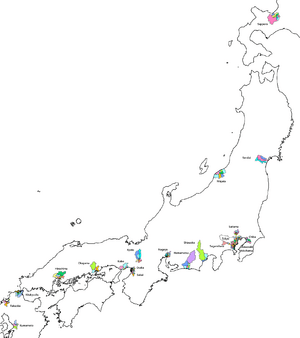Wards of Japan facts for kids
In Japan, a ward (called ku in Japanese) is like a special neighborhood or district within a very large city. These cities are so big that the government has given them a special status, allowing them to be divided into these smaller areas. Think of it like a city having its own smaller towns inside it, each with its own local office.
Wards are managed directly by the main city government. They help with important local tasks like registering families (called koseki), handling health insurance, and collecting property taxation. Many wards also have groups of residents who help with different community activities, even though these groups don't have official legal power.
What are Wards?
Imagine a huge city that needs to be organized into smaller, easier-to-manage parts. That's what wards are for in Japan! They help the city government serve its people better by having local offices closer to where everyone lives.
Different Kinds of Wards
There are two main types of wards in Japan:
Regular Wards
Most large Japanese cities, like Osaka, Nagoya, and Sapporo, are divided into these regular wards. Each ward helps manage local services for the people living there.
Here are some examples of cities and their wards:
- Chiba: Chūō, Hanamigawa, Inage, Midori, Mihama, Wakaba
- Fukuoka: Chūō, Hakata, Higashi, Jōnan, Minami, Sawara, Nishi
- Hamamatsu: Chūō, Hamana, Tenryū
- Hiroshima: Aki, Asakita, Asaminami, Higashi, Minami, Naka, Nishi, Saeki
- Kawasaki: Asao, Kawasaki, Miyamae, Nakahara, Saiwai, Takatsu, Tama
- Kitakyushu: Kokurakita, Kokuraminami, Moji, Tobata, Wakamatsu, Yahatahigashi, Yahatanishi
- Kobe: Chūō, Higashinada, Hyōgo, Kita, Nada, Nagata, Nishi, Suma, Tarumi
- Kumamoto: Chūō, Higashi, Kita, Minami, Nishi
- Kyoto: Fushimi, Higashiyama, Kamigyō, Kita, Minami, Nakagyō, Nishikyō, Sakyō, Shimogyō, Ukyō, Yamashina
- Nagoya: Atsuta, Chikusa, Higashi, Kita, Meitō, Midori, Minami, Minato, Mizuho, Moriyama, Naka, Nakagawa, Nakamura, Nishi, Shōwa, Tenpaku
- Niigata: Akiha, Chūō, Higashi, Kita, Kōnan, Minami, Nishi, Nishikan
- Okayama: Higashi, Kita, Minami, Naka
- Osaka: Abeno, Asahi, Chūō, Fukushima, Higashinari, Higashisumiyoshi, Higashiyodogawa, Hirano, Ikuno, Joto, Kita, Konohana, Minato, Miyakojima, Naniwa, Nishi, Nishinari, Nishiyodogawa, Suminoe, Sumiyoshi, Taishō, Tennōji, Tsurumi, Yodogawa
- Sagamihara: Chūō, Midori, Minami
- Saitama: Chūō, Iwatsuki, Kita, Midori, Minami, Minuma, Nishi, Omiya, Sakura, Urawa
- Sakai: Higashi, Kita, Mihara, Minami, Naka, Nishi, Sakai
- Sapporo: Atsubetsu, Chūō, Higashi, Kita, Kiyota, Minami, Nishi, Shiroishi, Teine, Toyohira
- Sendai: Aoba, Izumi, Miyagino, Taihaku, Wakabayashi
- Shizuoka: Aoi, Shimizu, Suruga
- Yokohama: Aoba, Asahi, Hodogaya, Isogo, Izumi, Kanagawa, Kanazawa, Kōhoku, Kōnan, Midori, Minami, Naka, Nishi, Sakae, Seya, Totsuka, Tsurumi, Tsuzuki
Special Wards of Tokyo
The 23 special wards in Tokyo Metropolis are a bit different. They act more like independent cities themselves, even though they are called "wards." This is because Tokyo used to be a single city, and these wards were its original parts. Now, they have their own local governments, similar to how a city would operate.
Here are the 23 special wards of Tokyo:
- Adachi
- Arakawa
- Bunkyō
- Chiyoda
- Chūō
- Edogawa
- Itabashi
- Katsushika
- Kita
- Kōtō
- Meguro
- Minato
- Nakano
- Nerima
- Ōta
- Setagaya
- Shibuya
- Shinagawa
- Shinjuku
- Suginami
- Sumida
- Toshima
- Taitō
See also
 In Spanish: Barrios de Japón para niños
In Spanish: Barrios de Japón para niños


